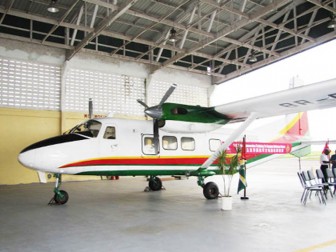Several army pilots who recently completed a training course to be command pilots to operate the Chinese Y-12 aircraft are peeved at not being given the opportunity to fly the aircraft solo.
This newspaper had reported on a press release sent out by the army at the end of May, which stated that members of the Air Corps unit had concluded a specialist training programme in the operation and maintenance of the Chinese Y-12 aircraft, which is expected to boost the unit’s previously-hampered operational capacity. The programme was conducted by China National Aero-Technology Import and Export Corporation (CATIC) at a cost of $100 million.
Stabroek News understands that soon after the course was conducted the army was expected to implement a process in which the five pilots were expected to fly alongside an experienced pilot in order to accumulate the required 20 hours before they could be checked out to operate the aircraft solo. However, reports are that only one of the five airmen is being allowed to operate the aircraft, bearing registration 8R-GDS, and according to a source within the unit, it remains unclear whether the four remaining pilots will be given an opportunity to fly the plane.

Senior officials could not be reached for a comment when this newspaper attempted to contact the army recently.
Stabroek News’ source explained that the course was undertaken in order to have two co-pilots and two pilot instructors as well as a command pilot trained by the Chinese to fully operate the aircraft. He said that when the aircraft was delivered in 2002 by the Chinese, it had only accumulated 200 hours and according to him, at the time two personnel from the army were fully trained to fly it.
He said there is a Flight Operations Officer, an expert in the field, who was also trained by the Chinese and that individual, who is contracted to the Jamaican government, is working along with the army to ensure that the four pilots complete the statutory hours before they can fly solo. However, the army currently has only one command pilot who was trained when the Twin Panda Y-12 aircraft was brought to these shores.
He said that over the past ten years, the command pilot has been flying the aircraft alongside a younger co-pilot and that on several occasions in the past the issue of training arose but was never addressed. Reports are that a proposal was made several years ago for army pilots to be trained and reports are that at the time, the cost amounted to some $83 million.
It was noted by another source that the command pilot selects who he wants to fly alongside him and this has led to the younger airman flying alongside him over the past decade.
The sources said now that the training course has been completed, the younger pilot is the only one of those trained by the Chinese recently who is being allowed to accumulate the required hours.
It was noted by this newspaper’s source that over the years, the Y-12 aircraft has only been travelling to 6 to 8 aerodromes across the country based on the request of the lone command pilot. It was noted too that the aircraft has attained approximately 2,000 hours since it came to these shores, flying an average of 15 hours per month. Persons at Air Corps related that the aircraft is under-utilized due to a lack of personnel even though there should now be a sufficient number of pilots.
Air Corps Commanding Officer Lieutenant Cargill Kyte said at the closing ceremony following the training course in May that the unit suffered a “deficiency” in the operation and maintenance of the aircraft.
The situation also impacted on the service delivery ability of the unit to the GDF and local communities. The course had a 100% success rate and six of its graduates are now eligible to have their licences endorsed by the GCAA.
Two years ago this newspaper had reported that there was one person at the GDF Air Corps who was qualified to pilot aircraft.
The aircraft was sourced by the government in 2002 to enhance the GDF’s capability to move cargo and passengers around Guyana as well as improve its aerial surveillance capability.
The aircraft, which was bought relatively new, can seat 19 persons and has a cargo capacity of 1,700 kilogrammes (3,748 lbs). Its engine was manufactured in Canada and the avionics in the United States of America.
It was bought from the Chinese government on concessionary terms in 2002 when the government announced additional budgetary allocations of $540 million for the previous year to the sector.




